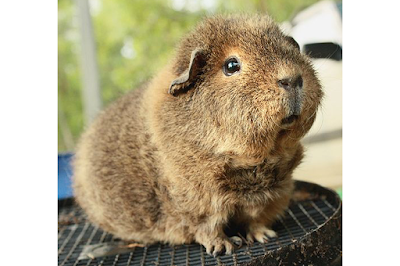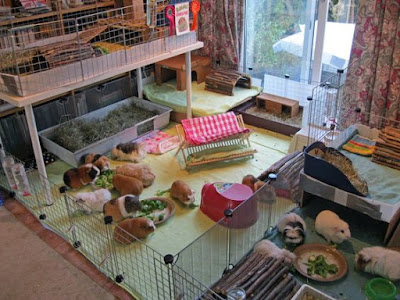Teddy Guinea Pig: The Cavy With A Teddy Bear Resemblance
Guinea Pigs have steadily grown in terms of popularity as a house Pet— while not everyone might consider them as a favourite amongst small animals, this does little to deter the genetic mutations for developing different coat and colour variants. Looking to own a Guinea Pig with a short coat that differs from the classic American Shorthair? The Teddy Guinea Pig might be a viable option ☺
 |
| Source |
Teddy Guinea Pig
Though the origin of this breed is still shrouded in mystery, studies and reports have long established the fact that ancestral Guinea Pigs were initially bred for food in early civilizations. Ancestors of Guinea Pigs were found as early as 5000 BC, where they were initially bred for food in tribes of the Andean Region in South America. Guinea Pigs were also used by Folk Doctors to study illnesses when Western Medicine was not available, nor as reputable as today.
Related:
American Shorthair Guinea Pig: The Oldest Breed Of Guinea Pigs
 |
| Source |
Teddy Guinea Pig Appearance
Size — The average size of a Teddy Guinea Pig is not far off from any other breeds. Adults grow to weigh an average of 700g to 1 kg, and length ranging from 20 to 30 cm.
Features — Another distinct feature would be the upturned nose of a Teddy Guinea Pig, which is rounder and wider than other Guinea Pig breeds.
Fun Fact #1 This nose is referred to as a Roman nose, the only two breeds that have this nose is the American and Teddy Guinea Pig.
Fun Fact #1 This nose is referred to as a Roman nose, the only two breeds that have this nose is the American and Teddy Guinea Pig.
 |
| Source |
Colours — Like most Guinea Pig breeds, the Teddy Cavy is available in a variety of colours and patterns ranging from Black, Brown, Grey, Cream and Agouti.
Grooming A Teddy Guinea Pig
You'd be glad to know that the unique short coat of a Teddy Guinea Pig is not prone to tangling or matting. It is still inevitably important to keep up the effort in brushing their coats at least once a week. Having a slightly more sensitive skin to other breeds, opt for a soft-bristled comb during brushing, and only give them a bath when absolutely necessary— once in one/two months. Abiding as such prevents over-drying of their skin.
Hot Tip #1 Guinea Pigs do not require sand baths. Instead, draw up a warm bath with a small amount of Pet-friendly shampoo if preferred, then drying them very thoroughly after.
Hot Tip #1 Guinea Pigs do not require sand baths. Instead, draw up a warm bath with a small amount of Pet-friendly shampoo if preferred, then drying them very thoroughly after.
 |
| Source |
In the event where you must clean your pet Cavy that only recently bathed, spot-clean affected/soiled areas with a damp cloth instead. Ears have to be wiped clean with a Guinea Pig friendly cleanser and cotton balls, and nails to be trimmed if they get too long.
Teddy Guinea Pig Personality
Guinea Pigs make excellent Pets largely due to their personalities. A Teddy Guinea Pig is a curious, fun, active and loving Cavy. Exploring their surroundings and being patted are amongst their favourite pastimes. Natural and instinctive behaviour of small animals may come of as extremely wary and cautious at first— have patience in gainging their trust. Begin so by feeding them by hand occasionally, just to get them accustomed to your prescence ☺
Fun Fact #2 In case you were wondering, Guinea Pigs are pretty sociable creatures and enjoy the company of other Cavies. In fact, it is advised that they are kept in a pair or more to keep loneliness away!
 |
| Source |
Guinea Pig Housing And Feed
Housing — All Guinea Pigs' homes should be filled with a good bedding of hay or soft material, toys and ample room for an active lifestyle and exploration— Wooden toys satisfy their chewing needs and prevent overgrown teeth.
Pine and Cedar wood bedding should be avoided as these are known to cause respiratory problems. Straw is also not advisable due to its level of absorbency.
Hot Tip #2 House your Cavies in an exclosed area large enough in accordance to how many Guinea Pigs you have and all their needs— this provides a safe and comfortable home for movement, feeding and rest.

Feeding — Good quality Hay is an absolute staple in a Guinea Pig's diet. Introduce a plate of good-quality hay with food pellets mixed in. Guinea Pigs require a ton of Fiber and Vitamin C, therefore the inclusion of fresh vegetables and occasional fruit treats are encouraged. Recommendations for good quality Hay types are Timothy Hay, for healthy teeth and good digestive systems.
Housing — All Guinea Pigs' homes should be filled with a good bedding of hay or soft material, toys and ample room for an active lifestyle and exploration— Wooden toys satisfy their chewing needs and prevent overgrown teeth.
Pine and Cedar wood bedding should be avoided as these are known to cause respiratory problems. Straw is also not advisable due to its level of absorbency.
Hot Tip #2 House your Cavies in an exclosed area large enough in accordance to how many Guinea Pigs you have and all their needs— this provides a safe and comfortable home for movement, feeding and rest.
 |
Hot Tip #3 Prevent your pet Cavies from eating soiled hay by regularly cleaning up their living space, and providing fresh food and water daily!
You might also be interested in these:
What Can My Guinea Pig Eat?: Guinea Pig Safe Greens and Fruits
You might also be interested in these:
What Can My Guinea Pig Eat?: Guinea Pig Safe Greens and Fruits
What Can My Guinea Pig Eat?: Guinea Pig Safe Greens and Fruits
Your Stories Can Be Heard Too
Do YOU have a story to share? Your voices are important to us and the Pets community! Our readers are encouraged to share their Pet-related reviews of a place and its services, experiences, even lifestyle tips and tricks to better our Pets lives, on our platform, one paw at a time. Be a part of an educational and informative Pets community because at ThePetsDialogue, your voices could make a huge difference on a global scale.
Write to us at [email protected] today!
Our website is a work in progress, however, if you did find our articles interesting please do feel free to share! For more Pet care tips and other Pet-related articles, head to www.thepetsdialogue.com ☺
Disclaimer
This article was written with informational purposes, as you know, we’d love to share our collective research and experiences as fellow Pet owners and lovers. It is not meant to alternate in any way as advice or diagnosis of Professionals.
ThePetsDialogue claims no credit for images posted on this article unless otherwise displayed/stated. All rights go to respective owners as mentioned. If you do not wish for your image(s) to appear here do drop us an e-mail and it will be removed promptly. If you do wish to use any of our original published information, you are welcome to contact us!




No comments:
Post a Comment